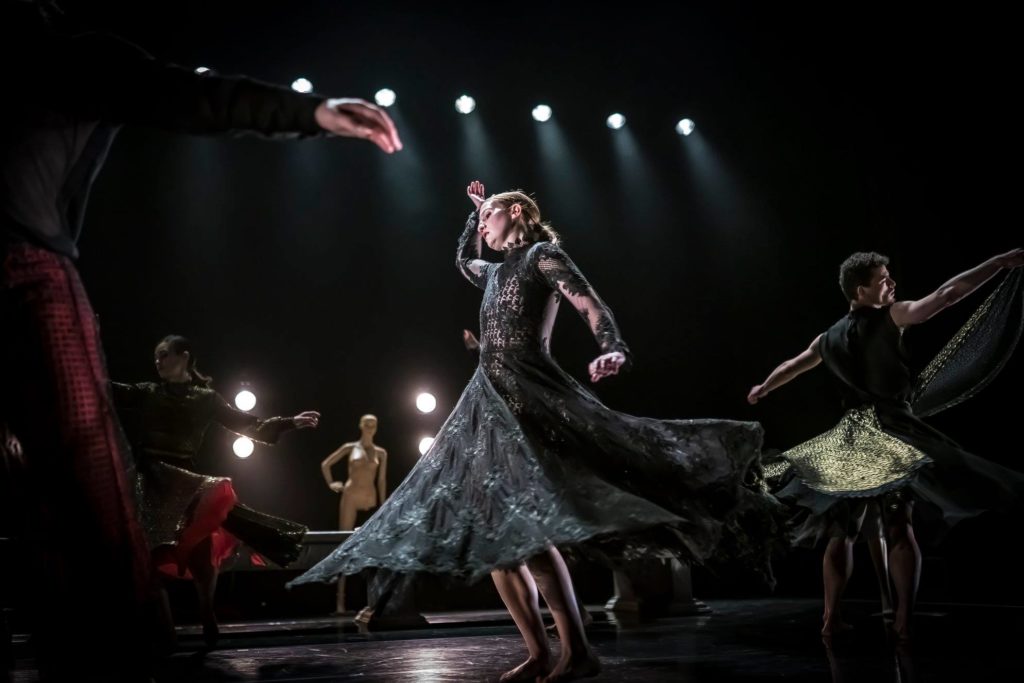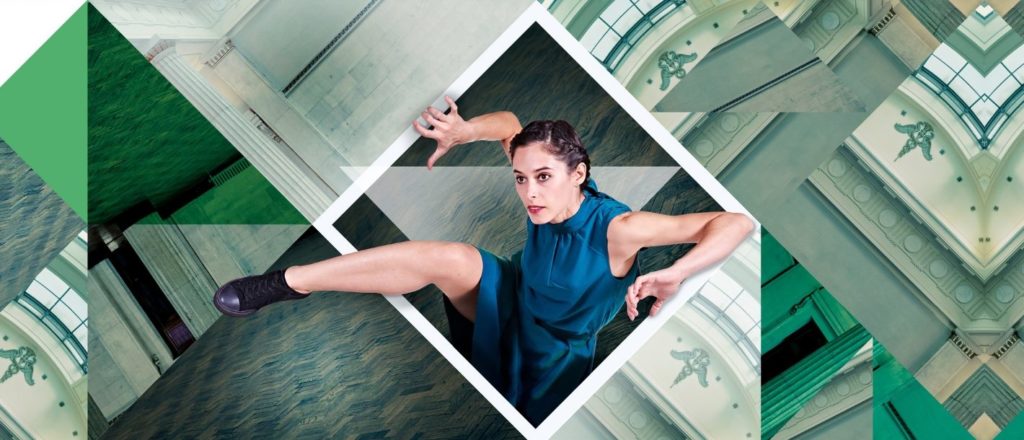
Courtney Sellick
Awakening is a mixed bill reflecting on National Dance Company of Wales founding’s of different international choreographers. The showcase involved three works: ‘Tundra’ by Spanish choreographer Marcos Morau; ‘Afterimage’ by Brazilian choreographer Fernando Melo; and ‘Reveller’s Mass’ by Caroline Finn the Artistic Director and now Resident Choreographer of National Dance Company.
‘Tundra’ is a partnered piece that involves the dancers being in sync throughout the whole piece. It has a history of Russian folk dance, mass parades and revolution which is why the dancers stay connected. The costumes were also inspired by Russian folk dance for example the skirts at the beginning gives a mesmerising image of them floating across the stage.
In the piece ‘Afterimage’ the dancers sit at a small table using other dancers behind a mirror interrupting each other’s reflections whilst moving, like showing two types of reality all in one. Although this is the shortest piece, it gives out so much emotion. Using an illusion technique called ‘Pepper’s Ghost’ shows exactly what it states…the dancers looking like sprits coming in and out of other bodies on stage which was very bewildering but breath-taking to watch.
‘Reveller’s Mass’ is a religious fervour with explorations of communion and ceremony involving a long water bath with candles in the middle which explains Da Vinci’s ‘The Last Supper’ mentioned in the programme. Ed Myhill gave a terrific performance as the cult leader and actually ended up being quite funny at the end of the work. Each dancer has a curious character in which they all come together using charismatic and compelling choreography.
Kristiina Kalinina
It was an absolute pleasure to see “Awakening” at Sherman Theatre Cardiff by National Dance Company Wales. The audience enjoyed 3 works (“Tundra”, “Afterimage” and “Revellers’ Mass”).
As a partly Russian person, I was impressed with “Tundra”. The choreographer perfectly modifies some classical Russian Folk Dance movements and fits them into the work. The idea of staying connected was probably taken from Folk Dances as well, but dancers were using their whole bodies to stay connected, not only arms, which I find really interesting and impressive.Not only movements were inspired by/ taken from Russian culture, but also costumes were created using some traditional Russian patterns. I am not sure if the music was Russian, but definitely had a Slavic motif. Apart from the connection with the Russian culture, I was in love with the lightning, a huge rectangle light and this play with the shadows gave me an unforgettable experience. I would recommend to anyone who is interested in bringing different cultures to contemporary dancing.
Danni Gordon
Tundra is a contemporary dance work that uses elements of Russian folk dance alongside an urban vocabulary. Marcos Morau’s bold style is robotically precise, trying to create something more human in that we used to work together, in terms of connections and community. These days we are all so disconnected.
This was the first time I had seen Tundra being performed live within the show Awakening, with no background information on it before watching the performance I was extremely mesmerised at the way it was both executed and how the design went so well alongside it. Being in first year on the dance course at USW I’m just starting to watch more varied dance performances and realise how much diversity there is within the dance sector, Tundra giving me an excellent insight into new ideas and concepts. Tundra was a delight to watch and really shows the connection and trust the dancers have between one another, allowing the audience to really relate to both the beautiful costumes that relate so well to the Russian Folk dance and harmonised precise movements.
I am glad I didn’t look at the background of Tundra before the showing of it as I feel it allowed me to have my own thoughts about the piece, before knowing the reasoning behind it. Having then looked at the programme notes it is clear what Marcos Morau wanted to explore and portray within Tundra. I think it is an extraordinary work that I would give a 5 star rating.
Don’t miss this incredible work Tundra choreographed by Marcos Morau, it’s a must see.
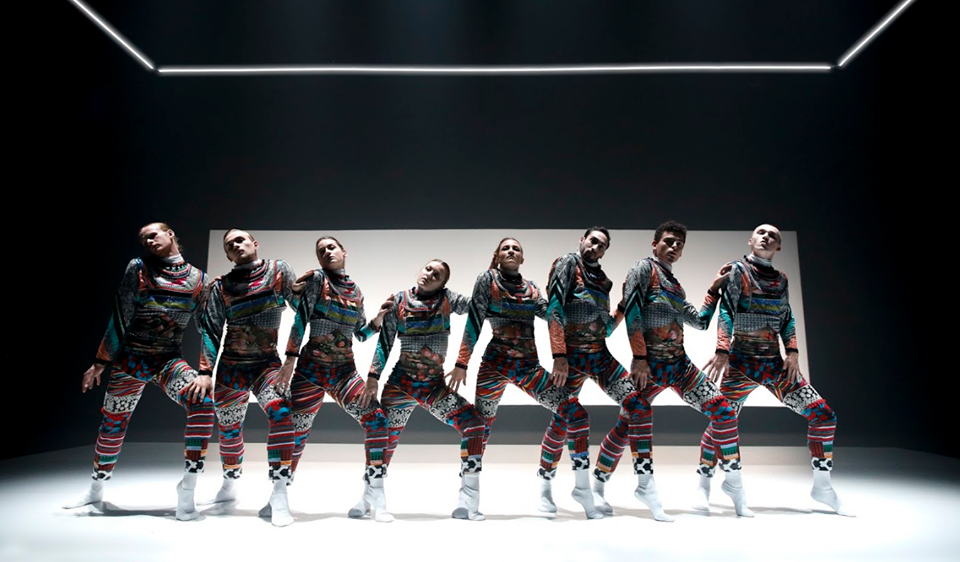
Becky Johnson
The evening began with Tundra, a nod to Russian tradition with a whirlwind of optical illusions. This is the third cast I have now seen perform the piece and each have brought their own dynamic to it. This time it wasn’t the swift canons nor the captivating opening sequence that brought my intention. Rather it was, the unified presence of the performers on stage. They didn’t seem like one entwining body which other casts had achieved but instead as individuals stood at a united front. Each with their own way of moving but held together by their defiant gaze and unified approach. This seemed more reflective of the Russian Revolution in which the piece was created in memory of. However, I must admit part of me longed to be dumbfounded at the pure skill in which the choreography provides. But upon reflection, I must acknowledge how a piece adapts with age and more so when you know a magicians tricks it’s a lot harder for something to seem magical.
Despite that, Afterimage was a piece that really resonated with me. I had been to see the open rehearsals last summer so was aware of how the trick of Peppers Ghost worked. However, this wasn’t a necessary surprise needed to be impacted by the simplistic beauty of the movements and the story within the piece. The powerful relationships between the performers left you delving for more clues and causing each audience member to create their own story as to why. When in fact, there could be endless possibilities. Something possibly more beautiful than what was happening on stage, was the pure amazement of the children sat behind me. Their squeals and gasps as different characters emerged and disappeared from the set. As well as their insistent debate of how the Company managed to achieve the magic that was occurring on stage.
The final piece was that of Revellers Mass, a farewell from Caroline Finn as Artistic Director of the company. The stage was filled with a community of characters each with their own story to tell. Once again Ed Myhill played the roll of the mastermind, a role he plays extremely well, and seemed the master puppeteer for the rest of the cast. The piece was one of those that you could watch multiple times and depending on your seat within the theatre your eyes would be drawn to different narratives throughout. Although I struggled to find sense of the ending, it provided a light hearted finish to what was a brilliant evening showcasing the skills and character of the new cast. I can’t wait to see them all grow as a company and to see what else that have in store for us.
Lizzie Chatfield
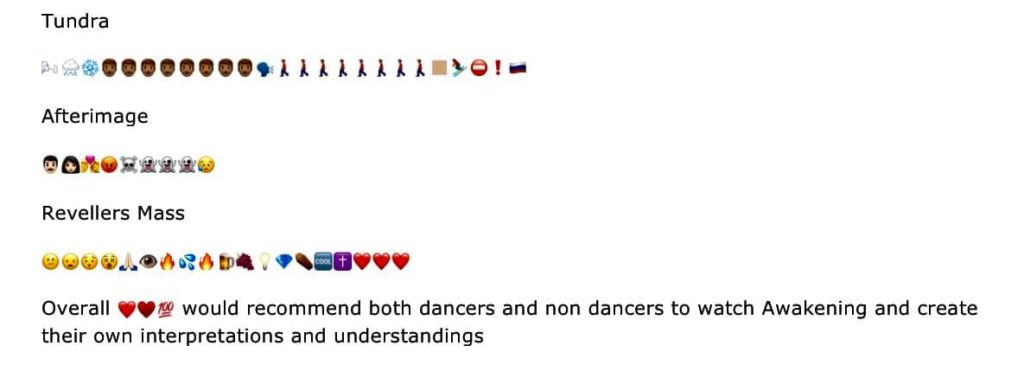

Bethany Lydon
As someone with a Roman Catholic upbringing watching Revellers Mass by Caroline Finn as part of NDCWales’ Awakening 2019, I could clearly recognise moments relating to the Christian Faith and I felt I was able to make so many connections with that performance! It was enjoyable and clever to have comedic moments where the audience actually laughed out loud! It’s not always you can watch a dance piece focusing around religion and laugh!! Would love to see this again.
Lucie Ainsworth
On Wednesday 1st May 2019 I got the pleasure of watching National Dance Company Wales at the Sherman Theatre in the spring tour of Awakening. The evening consisted of three captivating pieces, opening with Tundra choreographed by Marcos Morau, Afterimage by Fernando Melo and Revellers’ Mass by Caroline Finn.
When I originally watched Tundra for the first time I was already intrigued first of all by the opening section where the floor length skirts gave the illusion of hovering across the stage with ease, and then the simplistic movements, but performed within half counts of each other to look as if moving across the stage as one being. However seeing this performance for the second time for myself made it even more interesting to watch. Having learnt sections of the repertoire from two of the company members earlier on in the year was what made it even more engaging to watch. About to enter the professional industry means that when you watch this work and have had the chance to learn it, makes it feel more accessible and less daunting to think about graduating.
Afterimage was an interesting watch with its visual effects happening live on stage making it seem like there are two dancers dancing in each others space. I do think for this piece it would vary what your reaction may be depending on where you sit. I would be keen to see it again from a different angle to experience what I may notice next time.
Revellers’ Mass felt far more familiar to me as a piece based on what I have seen the company do so far. Similar to Finn’s other works in my opinion like Green House and Folk. The piece was lively and energetic and reminded me of when I saw then company for the first time back in September 2016. Although the company members have shifted and changed since i’ve been in Cardiff, it’s been lovely to see how each new member added in to the company brings something new to the dynamic of the works.
Rhiannon Stalley
National Dance Company Wales are a company that I really enjoy to watch in performance, as they always seem to exceed my expectations, and pull off everything I believe that they set out to do.
Awakening was made up of three works, Tundra by Marcus Morau, Afterimage by Fernando Melo, and Revellers’ Mass by Caroline Finn. Tundra is a piece that I have now seen twice, and is one of my favourite works from the company. The way the dancers come together to create such an incredible image has me captivated, and really takes me on the journey with them. Tundra is said to be “as mesmerisingly beautiful, as it is robotically precise.” For me I believe this is exactly how the piece portrays itself. Every time I have seen the work I have been put into a complete state of euphoria.
I really recommend watching all of the works performed in awakening, especially Tundra.
Zoe Mutter
I am currently a student at the University of South wales studying dance, I thoroughly enjoy watching National Dance Company Wales works at any showing or sharing they offer. On the 1st of May we went to The Sherman Theatre to watch Awakening. This showing included three amazing works created by Marcos Morau, Fernando Melo and Caroline Finn. Each work was completely different yet still flowed next to each other in the show.
The first work to been shown was Tundra, now this is the third time I have watched Tundra and it still gives me chills to this day. Watching the precision of 8 dancers moving in sync with each other on a bare stage is a remarkable thing, it’s something so aesthetically pleasing that I find myself being mesmerised. Watching Tundra as an open rehearsal to being performed and toured feels like I have seen it grow into bigger and better things performance by performance.
The second work to be performed was Afterimage. This piece completely captivated me in seconds. Going in fully blind to this piece I had no pre assumption or wants. It was 20 minutes of pure amazement, the use of an old “trick” really blew my mind, and to see it be used in such a well thought way with decorum and elegance was beautiful to watch. From beginning to end I couldn’t take my eyes of the stage, movement and dancers.
The final work was Revellers’ Mass the scenery, music, costume and movement took this piece from just a dance work to a truly fascinating performance. Just like all of the pieces I became enthralled by this piece. Its pace made it impossible to notice you’d been watching 7 dancers for 32 minutes. The movement felt like it took you on a story through the work, and the performativity displayed by all the dancers had me on the edge of my seat from beginning to end. Overall Awakening was a one of the most enjoyable and creative shows I have seen in a very long time, I would recommend for anyone to see these work. I will always be grateful to be able to watch this company and for letting me be inspired at ever show

Daniella Powell
Where do you get lost in a whirlwind of movement that is in a world of visual awe?
Whilst engaging in National Dance Company Wales’s Awakening tour which showed off a variety of three different dance works, Tundra; Marcos Morau, Afterimage; Fernando Melo and Revellers’ Mass; Caroline Finn it was evident that the dancers alone were in direct correlation not only with themselves, each other and the music but the use of lighting within those dance works seemed to contrast throughout by adding significant mood swings in to and from one scene to the next which made them all unite as one.
Tundra set the mood itself with the dynamic, electronic and cybernetic world as Morau described it as. How did Morau show this statement through movement and visuals? The strobe lighting and effect which pierced the audience’s eyes as these sharp energetic rigid small animistic gestures being performed contrasted this somewhat settle plain light with a series of layering gestures performed by the company making the work dynamic for the audience’s eye.
In contrast to this Fernando Melo’s piece (Afterimage) is the focus point of my review where I ask the question, what makes this performance? A male dancer dressed in a navy blazer and round neck t shirt sets the scene amidst the dull lighting and sits comfortably on a wooden chair with his arms laid out across the table that is placed to the right side of him. A series of arm gestures are performed with the introduction to the mirror that surrounds the scene which constantly reveals, hides and manipulates the movement of the dancer as Melo even spoke about this being a main priority to his work.
As the piece goes on, we indulge in a series of uncertainty as to which side of the stage the dancers are at, were they at the mirrored, or the fore front space? As we get absorbed into the layering effect that spears right the way back through the dull black back drops that captures a multi layering mirrors of that one person performing.
These idiosyncratic of the lighting and sound being used throughout the works that the company brought to the stage of their Awakening tour presented a variety of how dancers can captivate the audiences with not only their bodies connecting but their connection towards the musicality and visual effects.
“Captivating pieces, majestic and powerful dancers, who drew me in closely with the subtly in their movements”
Samantha Underwood
‘Spring Awakening’ performed by National Dance Company is one not to miss. As a student studying dance and a former Associate of the company it was inspiring to see the range of what contemporary dance could be in a professional context. During this performance the company performed three works ‘Tundra’, ‘Afterimage’ and ‘Revellers’ Mass.’
‘Tundra’ choreographed by Marcos Morau explores the theme of the Russian Revolution. The dancers predominately dance in unison and are frequently connected to one another. This can be said to reflect how a variety of different classes came together to revolt against Tsarist Russia. This work is full of intricate details and precise timings to form an overall specific image, because of this it is very clear to the audience when something goes wrong. However, during this show the dancers executed it with a fairly high level of dynamic precision. Their captivating performance alongside the set creates a tense environment for all who watch. As an aspiring dancer this work seems like a daunting challenge. The level of precision that is required to perform this work amazes me every time.
The second piece ‘Afterimage’ was choreographed by Fernando Melo. This work was a huge contrast to the previous work, a much more softer and subtle performance. The piece involved mirrors on stage to create the illusion technique Pepper’s Ghost. This effect allowed the dancers behind the mirror to appear and disappear at various points in the piece. The dancers in front of the mirror interact with the other dancers to look at social interactions and how different people communicate with one another. This piece was a reflective piece, there was no specific storyline so you could interpret the piece however you wanted to. This form of contemporary dance highlights the power of dance as a form of communication, the work could say something completely different to everyone else. This enables the audience to question what the piece means to them and why.
‘Revellers’ Mass’ was the final piece, choreographed by Caroline Finn. The piece was inspired by ‘iconic religious paintings,’ however while being based on these religious images the overall performance was a fairly light hearted piece that focused on a variety of different characters. The characters in this work portrayed a variety of emotions while once again showing how contemporary dance can be numerous things. The choreography alongside the engaging performance of the characters created a fully immersive piece and was the perfect way to the end the show.
‘Spring Awakening’ is an ideal performance for anyone who is interested in contemporary dance or anyone who is curious as to what it is. In these works National Dance Company Wales highlight how it can be precise, dynamic, reflective and characteristic.
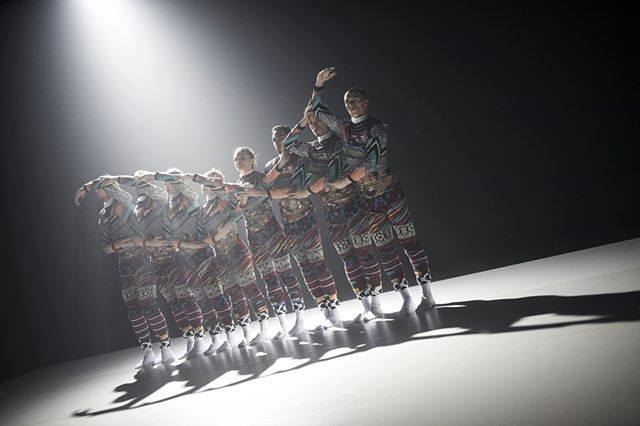
Lucy Lock
National Dance Company’s Wales ‘Awakening’ was an elating evening of dance works filled with culture, history and compelling narratives.
Tundra uses visual illusions with body and costuming to create an overall bigger image and visual art. Dehumanising the dancers to appear robotic and as if they are a part of something bigger, working as one.
Afterimage uses two-way mirrors to create multiple versions of the dancers, adding layers for the audience to decide what the interactions between the dancers may be, whether they be an after image or in the forefront.
Revellers’ Mass is an elaborate production with intriguing and intricate interactions between performers with imaginative and expressive choreography. The piece includes light and dark moments and humour. The whole work had me on the edge of my seat trying to get a closer look to become more immersed in the narrative.
A thoroughly enjoyable evening and a well thought out programme of productions. All costumed impeccably, with innovative visual effects, props and wonderful accompaniment

Stephanie Jones
Awakening by National Dance Company Wales was a show that consisted of three dance pieces, Tundra, Afterimage and Revellers Mass.
In this review I will be focusing on the dance piece; Tundra. This piece is based off of Traditional Russian Folk dances, mass parades and revolution, but in a more modern context. This piece was created by Marcus Morau.
The first thing I want to talk about is their costumes. The costumes were colourful, patterned jumpsuits paired with plain white socks. I thought the costumes were bold and after watching some videos about traditional Russian folk dances I can see that they were trying to take some of the details out of traditional Russian costumes to put into their piece.
I really enjoyed this piece because it kept me engaged from the beginning. In the beginning it looks like the dancers are floating around the stage but they’re actually doing lots of really fast, little steps. After watching the videos of traditional Russian Dances I also saw that they were using some of the moves but in a different way. They stayed connected a lot in a line, just like they do in Russian Folk dances so they have tried their best to explore these movements and structures.
This is definitely a piece I would watch again. It is full of energy and all the dancers were coordinated. I especially liked how they used foam towards the end of the dance to make it look like snow. I would give this performance a five star rating.
Martha Dunbar
The piece that stood out to me the most from the three brilliantly executed works on this tour was Afterimage. Now I’m not sure whether that is because I have previously watched Tundra on stage and the rehearsals for Reveller’s Mass, but something in Afterimage resonated with me on a personal level.
The appearing bodies that seemed to be ghostly behind the body on stage created many enigmas for me throughout watching the piece which is what I really enjoyed about the watch. The multiple scenarios and relationships created allow the audience to connect and relate to their own past or even present situations. From the first sighting of the clever, thought through optical I connected very personally to every situation/relationship that I saw.
I can’t pin point what it is exactly about the creative imagery that was stuck with me for so long after watching the work, but the delicate precision of the dancer’s movements definitely made it an incredible watch. Having not known anything about the piece before seeing it the first time definitely wouldn’t hinder my decision to watch it again.
Emily Lloyd-Reed
The performance at the Sherman Theatre consists of three works which are broken up by two 20 minute intervals. The works are: Tundra by Marcos Morau which is 30 minutes, Afterimage by Fernando Melo which is 20 minutes, and Revellers’ Mass by Caroline Finn which is 32 minutes.
There is a mixed audience for these works as they are all very different. The programmes for Awakening provide a good amount of detailed information on the works, and it even provides us with insight to the things the choreographers have explored and thought of whilst creating them.
The first work, Tundra, is intense and serious but also feels that there are some playful aspects to it. The opening to this work is a single dancer in the space. This opening feels misplaced because the lighting is a red square in the centre and is dark at this point and the movement of the dancer isn’t clear because of it. However, this opening does give some cultural context of the work. The 8 dancers in the work appear as Russian dolls wearing patterned tops, long skirts and float around the space creating different spatial patterns. The dancers exit and re-enter the space without the skirt on, instead we can see they are wearing an all-in-one costume which is colourful and patterned. They do very precise and linked movements throughout, either in canon or unison. Marcos Morau says Tundra is inspired by “Russian folk dance” which is why “the dancers are chained and connected”.
Afterimage is a very clever work where the images of the dancers appear, disappear, and multiply. The programme says that Afterimage gives the audience scenes to help them create a “personal response” but “without providing a single narrative”. This work feels quite ghost like, especially by people doing movement in unison either side of the mirror, as it looks like the person behind the mirror is their ghost figure to the person dancing in front of the mirrors.
The set for Revellers’ Mass is a long table towards the back of the space which is a representation of the Last Super. We can see this table is filled with water as the dancers stand and perform on it. There are candles on the table which are lit by one dancer whilst church bells ring. This brings a religious aspect to the work. This is also done using mannequins, as they can be seen as religious figures/statues. The work begins to get wild towards the end where the dancers are dancing with the mannequins or limbs of them and are also splashing the water on the table. However, this calms down by a male dancer walking and standing centre stage whilst the song ‘Non, je ne regrette rien’ by Edith Piaf is played.
Simultaneously, the other dancers are cleaning up the mess on the stage which was created by their wildness.
Fantastic to experience such a range of inspiring choreography and an articulate performance.
